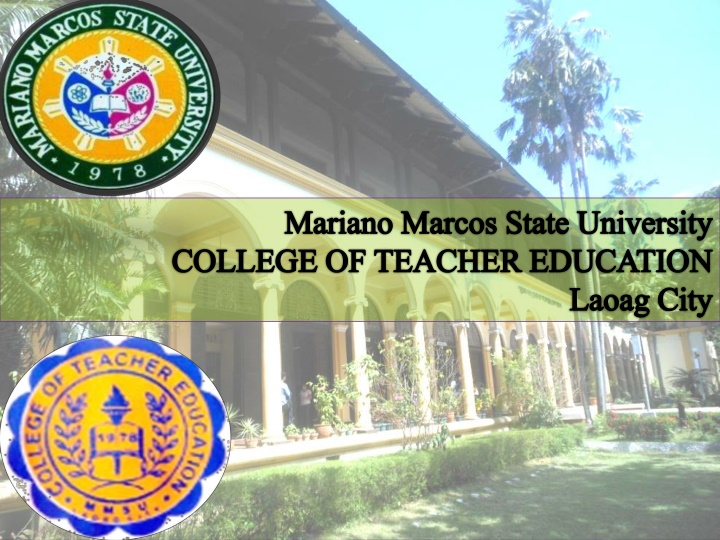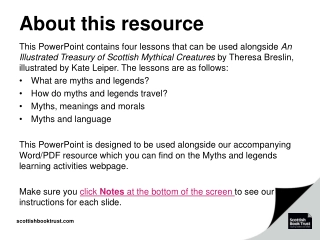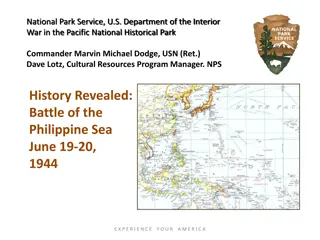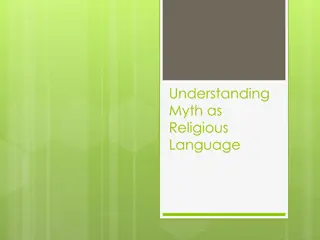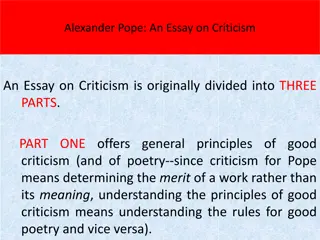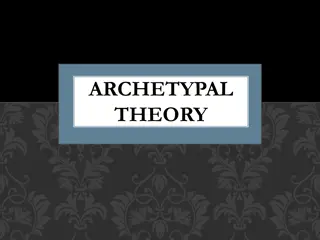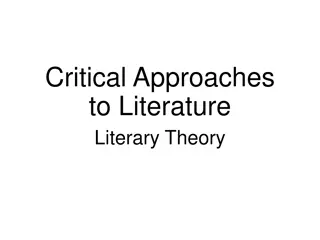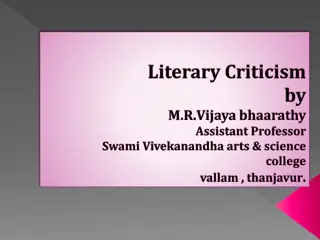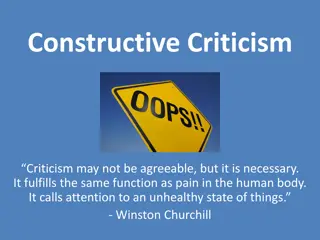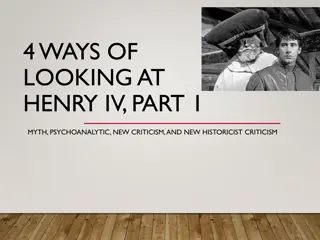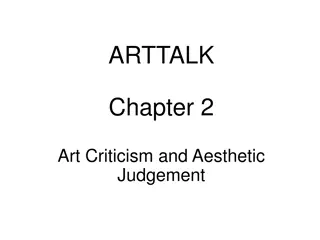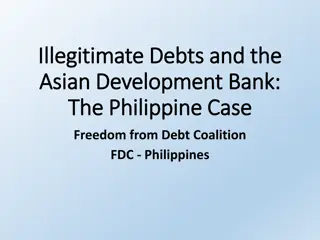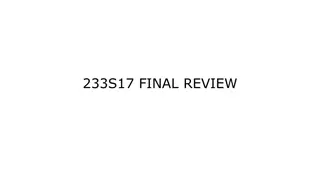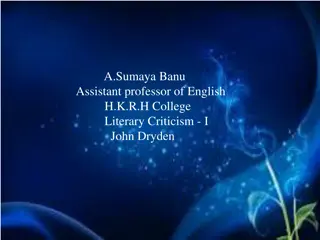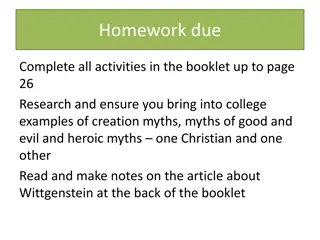Archetypal Criticism in Philippine Myths
Delve into the theory of archetypal criticism as applied to two iconic Philippine myths - Sandayo and Tuwaang. Explore how recurring archetypes, symbols, and character types shape the narratives, providing insights into cultural and psychological myths. Witness the extraordinary tales of heroes born through unique circumstances and their journeys of courage and love in the face of adversity.
Download Presentation

Please find below an Image/Link to download the presentation.
The content on the website is provided AS IS for your information and personal use only. It may not be sold, licensed, or shared on other websites without obtaining consent from the author.If you encounter any issues during the download, it is possible that the publisher has removed the file from their server.
You are allowed to download the files provided on this website for personal or commercial use, subject to the condition that they are used lawfully. All files are the property of their respective owners.
The content on the website is provided AS IS for your information and personal use only. It may not be sold, licensed, or shared on other websites without obtaining consent from the author.
E N D
Presentation Transcript
Mariano Marcos State University COLLEGE OF TEACHER EDUCATION Laoag City
THE THEORY OF ARCHETYPAL IN LITERATURE: A Study Guide on the Philippine Myths: Sandayo and Tuwaang
BACKGROUND OF THE THEORY OF ARCHETYPAL IN LITERATURE It is a type of critical theory that interprets a text by focusing on recurring archetypes in the narrative, symbols, images, and character types in a literary work. myths and
SANDAYO (OVERVIEW) Sandayo, of the Subanon, tells of the story of the hero who is born through circumstances as he fell out of the hair of his mother while she was combing it on the ninth stroke. Thence, he leads his people in the fight against invaders of their land and waterways. extraordinary
TUWAANG (OVERVIEW) It is a tale of the Manuvu about a certain wedding named Tuwaang, who became the bride s groom. guest
THE GENERAL PRECEPTS OF ARCHETYPAL CRITICISM
Line/words Evidence of the General Precept General Precept Justification 1. Archetypal criticism agrees that archetypes determine the form and function of literary works that a text s meaning is shaped by cultural and psychological myths. In particularly Subanon, the betel-nut chew is a cultural symbol for acceptance of love usually given by women to their love interest. Mindanao, Sandayo shows his affection for Bolak Sonday by accepting her mama or betel- nut chew. in Before weddings, it is a custom for men to give dowry or a part of their wealth to the woman whom they will marry. Tuwaang produced his dowry with his mysterious breath.
Line/words Evidence of the General Precept General Precept Justification 2. Archetypal criticism proceeds from the initial assumption that every work of literature can be categorized and fitted into a large framework that encompasses all literature. Sandayo is brought to the center of the sun by his monsala or scarf. In the two myths, both of the main characters possess mythical means transportation such as the scarf of Sandayo lightning of Tuwaang. of Tuwaang rode on his lightning and soon reached Kawkawangan. and The two common motifs such as the musical instruments dowry. myths have Using his magic, Sandayo produces the dowry composed of money, gongs and jars. for With his mysterious breath, Tuwaang produced a gold flute, guitar and gong.
Line/words Evidence of the General Precept General Precept Justification The presence of comb is evident in both literary pieces but they differ in meaning. Wherein, the birth of Sandayo, the comb was an instrument of his birth. Tuwaang, the comb was used to express the affection of a woman to a man. Salaria combed her hair and on the ninth stroke, Sandayo was born. Before Tuwaang proceeded to the battle, the bride combed his hair dearly. While in
Line/words evidence of the general precept General precept Justification 3. The archetypal hero appears in all religions, mythologies, and epics of the world. He is an expression of our personal and collective unconscious. In archetypal criticism, an archetypal undergo to namely: The mother of Sandayo combed her hair after taking a bath in the river and on the ninth stroke, Sandayo was born. hero the must stages The archetypal hero must have undergone mythical birth. There subjugation of enemies. must be a Sandayo had a battle with Domondianay which lasted for two years.
Line/words evidence of the general precept General precept Justification An archetypal hero must be in an initiation wherein he is involved in an adventure and he is separated from his family. Sandayo lived in Liyasan while his family resides in Lumanay. The archetypal hero may die but at the end, he should be resurrected . When Sandayo died, the two ladies found out that his soul was a captive of the Amazons of Piksiipan. The two ladies recovered his soul and resurrected him
THEGUIDE QUESTIONS
1. Is the texts meaning shaped by cultural and psychological myth? 2. Are there archetypes considered as the unknowable basic forms personified or recurring images, symbols and patterns? concretized in
3. Does the literary piece focus on the history of gods and other allusions that involve mythology? 4. Are the symbols used in the literary piece universal?
5. Does the archetypal hero in the literary piece undergo archetypal events such as mythical birth, subjugation, transformation and return? initiation,
REFERENCES Archetypal Criticism. Retrieved on October 12, 2014, from http://www.powershow.com/view/3b0ac1- NTNlN/Archetypal_Criticism_powerpoint_ppt_presen tation Free Essays on Summary of Tuwaang attends a Wedding. Retrieved on October 13, 2014, from http://www.brainia.com/topics/summary-of-tuwaang- attends-a-wedding/0 Philippine Folk Poetry. Retrieved on October 13, 2014, from http://en.wikipedia.org/wiki/Philippine_epic_poetry
THE THEORY OF This ARCHETYPAL IN LITERATURE: A Study Guide on the Philippine Myths: SANDAYO AND TUWAANG was formulated to address the needs of the students as well as the teachers in studying literary criticism. Furthermore, this could be a useful guide for the Literary Criticism students for it serves as an avenue for them to learn the theory of archetypal as well as to facilitate in analyzing different literary pieces using this theory. Moreover, this presentation includes a Philippine Literary myth which will be helpful for the Filipino Students since there is a shortage of published Philippine Literary Pieces. PowerPoint presentation
THE THEORY OF This ARCHETYPAL IN LITERATURE: A Study Guide on the Philippine Myths: SANDAYO AND TUWAANG was created by Ma. Irene Carlina Guerrero and Angel Gabriel Lerios with their consultant Professor Jahnese Asuncion. This presentation is one of the collection of presentations about the different trends and theories of Literary Criticism by the BSE Junior students of Mariano Marcos State University College of Teacher Education major in English, taking up Literary Criticism subject. PowerPoint presentation
ABOUTTHEWRITERS MA. IRENE CARLINA G. GUERRERO is currently taking up the degree of Bachelor in Secondary Education with English as her field of specialization at the University College of Teacher education (CTE), Laoag City. At present, she is an active officer of the Student Council and the Communication Arts Guild. Mariano Marcos State ANGEL GABRIEL C. LERIOS is currently taking up the degree of Bachelor in Secondary Education with English as his field of specialization at the Mariano Marcos State University College of Teacher education (CTE), Laoag City. At present, he is a consistent qualifier in the national musical competitions .
ABOUTTHE EDITOR / CONSULTANT Jahnese Domingo-Asuncion is a professor at the Mariano Marcos State University College of Teacher education (CTE), Laoag City. She finished the degrees of Bachelor in Secondary Education, major in English and Minor in Social Studies; and Masters of Arts in Education, major in Language and Literature at MMSU. She is currently enrolled in Doctor of Philosophy in Linguistics. She teaches Language and Literature courses in the collegiate level. She was also involved in training Korean and Chinese students in the English Crash Course Program for foreign students of CTE. She is currently the co-adviser of CTE Bulletin and the Coordinator of Student Activities.
Unauthorized use and/or duplication of this material without express and written permission from this blog s authors is strictly Excerpts and links may be used, provided that full and clear credit is given to the authors with appropriate and specific direction to the original content . THANK YOU !!! prohibited.
